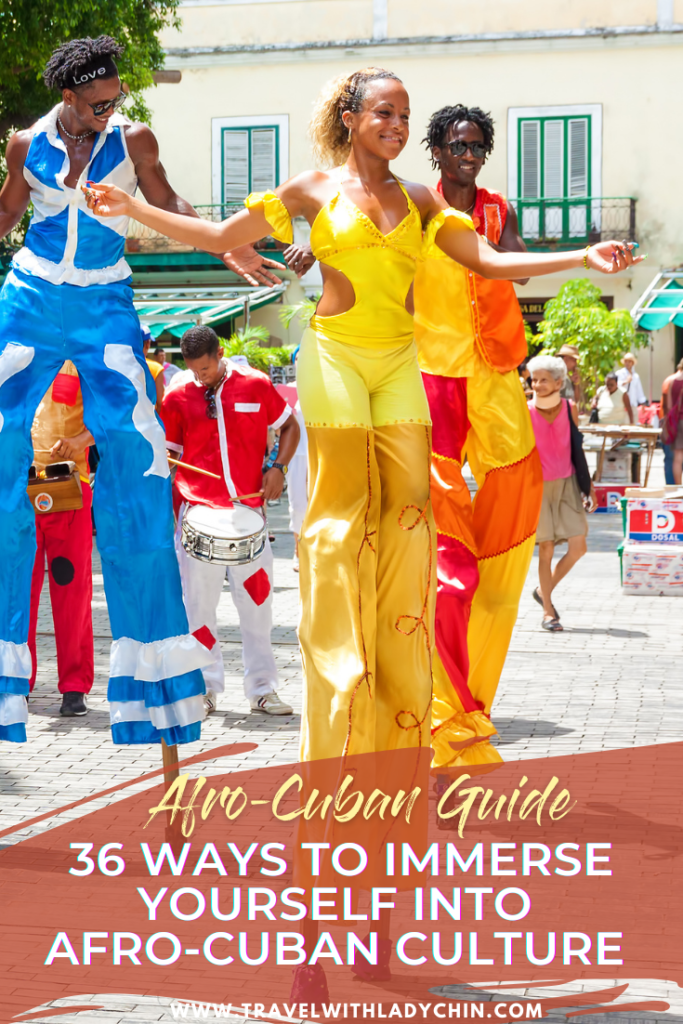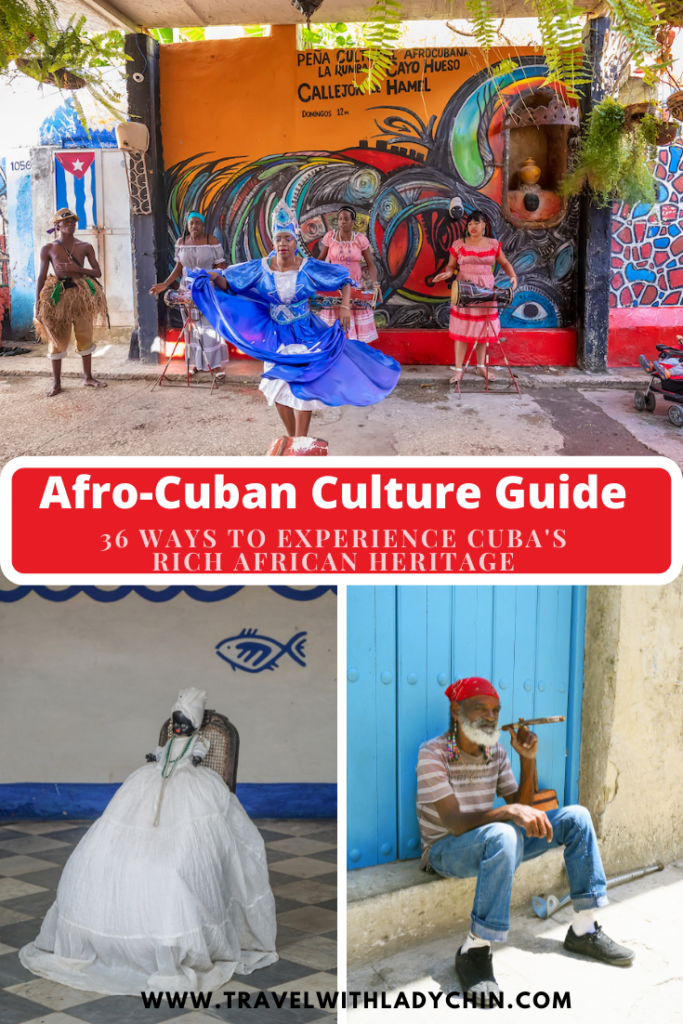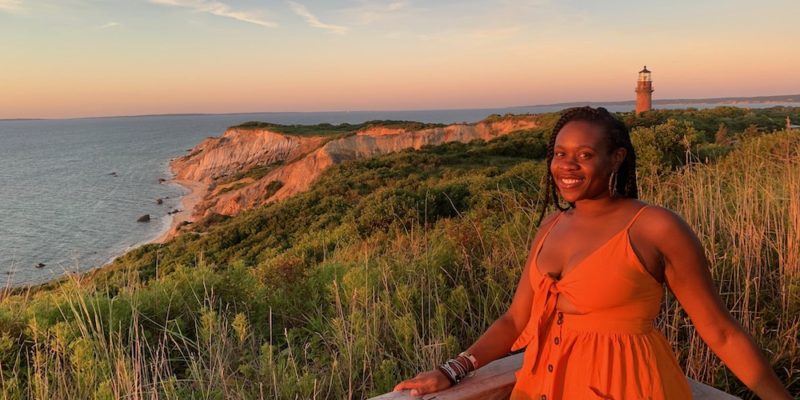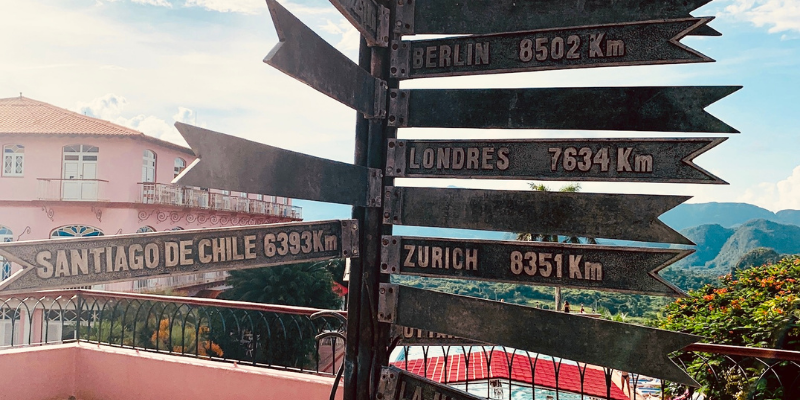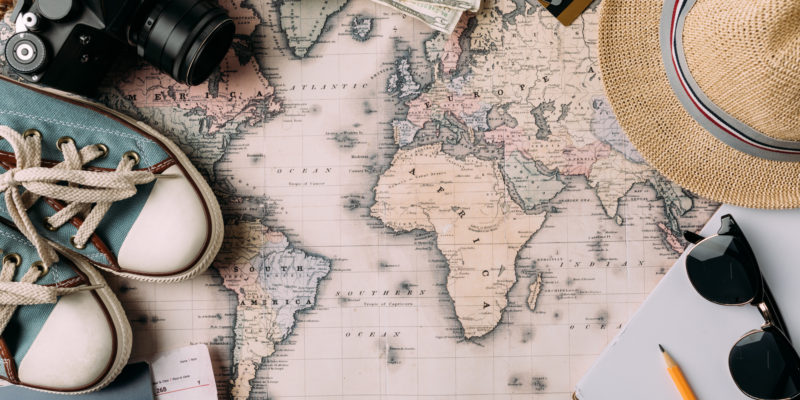Last Updated on September 20, 2023 by Lady Chin
Cuba is one of the few places in the world where I feel the most celebrated and welcomed. During my first trip, I noticed the apparent cultural similarities between Nigeria, where my family hails, and Afro-Cubans.
I quickly discovered that African influence was everywhere, from the food traditions to the music to the art and religion.
I was fascinated and wanted to know more about the origins of Afro-Cubans. To my dismay, I found the tour books didn’t go into great detail about Afro-Cuban culture.
That’s why I put together the ultimate Afro-Cuban culture guide to help you experience Cuba’s rich African heritage when you visit. This guide provides you with an understanding of the people, history, religion, culture, and traditions you need to know before you go.
Pin Me for Later!
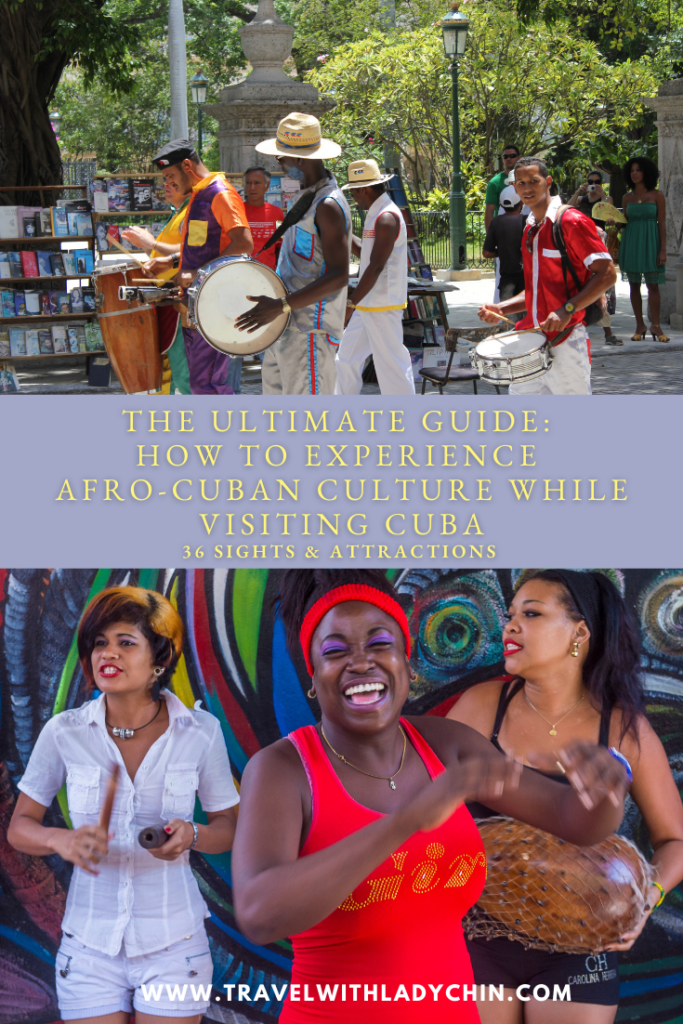
This is the third post in the Cuba series. Here’s the complete 10-part series:
Cuba Travel Series
Travel Guide: The Complete Travel Guide For First Time Visitors
Money Honey: Cuban Currency Guide: Everything You Need To Know
For The Culture: 36 Ways To Immerse Yourself in Afro-Cuban Culture
The Ultimate Cuba Bucket List: 101 Fun Things to Do in Cuba
Cuba Bucket List: Top 10 Epic Things To Do in Cuba
Packing Tips: The Complete Guide To Packing For Your Trip To Cuba
Inspiration: 30 Photos That Will Inspire You To Visit Cuba
Travel Tips: 10 Things You Should Know Before Visiting Cuba
Trinidad: Trinidad Travel Guide – How To Explore Trinidad in 3 Days
Viñales: How To Take the Perfect Day Trip From Havana To Viñales
Who are Afro-Cubans?
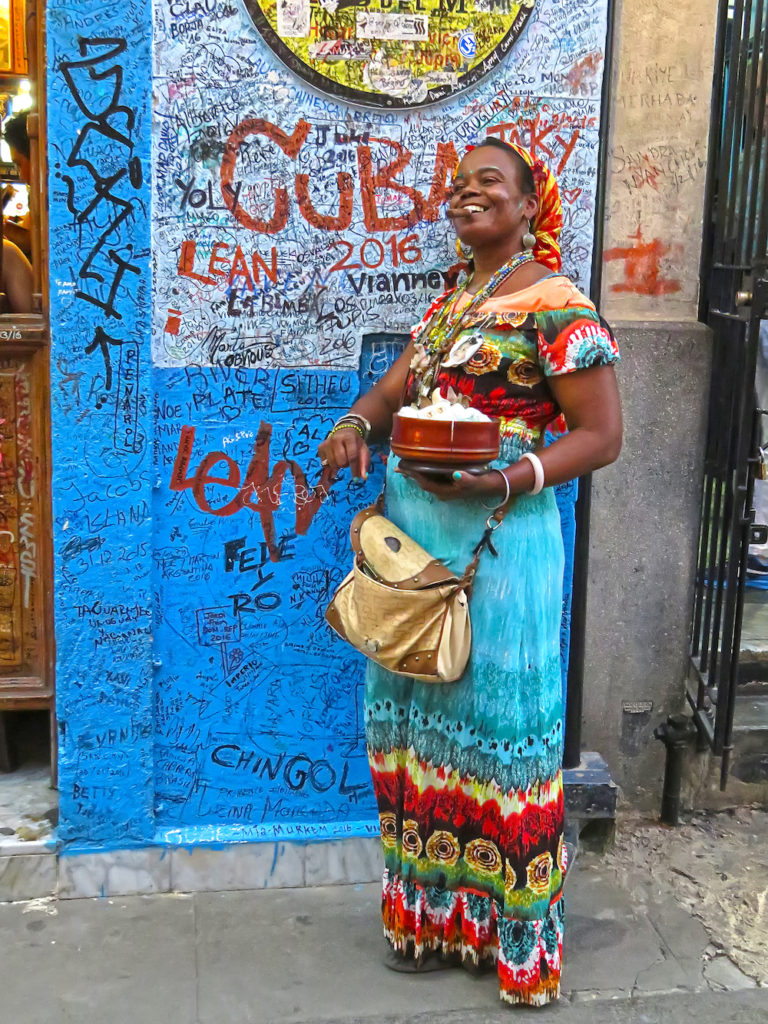
Afro-Cubans are Cubans of West or Central African ancestry. According to the 2020 National Consensus, the 11.3 million population of Cuba consists of the following ethnic groups: 64.1% White, 26.6% mulatto or mestizo, and 9.3% Black (2012 est.).
Sadly, due to internalized racism existing in Cuba, the numbers above aren’t as accurate and are believed to have under-reported Black and mestizo populations.
Some African ethnic groups and religions include Yoruba, Akan, Arará, Kongo, Igbo, Carabalí, Mandingo, Kissi, Fula, Makua, etc.
Origins of Afro-Cubans
Approximately 800,000 enslaved Africans were brought to Cuba due to the transatlantic slave trade, including Nigeria (home of the Yoruba and Igbo cultures), Spanish Guinea, and Angola.
That’s twice the number of enslaved Africans that arrived in the United States.
In the 18th century, Cuba became the largest sugar producer, and by 1839, Havana had the most significant population of enslaved Africans in the Caribbean.
36 Ways To Immerse Yourself into Afro-Cuban Culture: Things To Do By Location, Region, and Destination
Read on to discover the variety of Afro-Cuban sights and attractions broken down by each city so you can incorporate them into your itinerary.
Havana
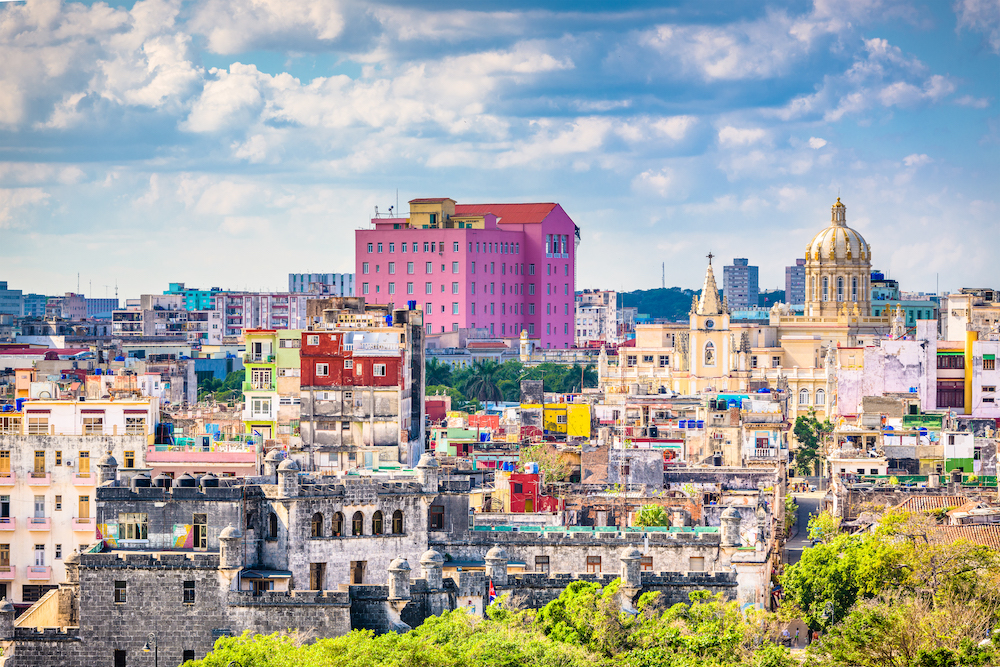
La Habana (Havana), founded by the Spanish in the 16th century, is the capital of Cuba and is home to the largest population of Afro-Cubans in any city on the island.
This city attracts over a million tourists annually and is known for its vibrant history, culture, architecture, and monuments.
- Visit La Casa de África (The House of Africa) – located in a seventeenth-century mansion Casa de África provides the historical context of Afro-Cuban culture and religion.
This three-floor museum displays ritual masks, ivory carvings, and textiles from African countries, along with a section dedicated to the Santería religion.
Every Saturday, the museum offers free educational and music programs. Afro-Cuban families from Havana and neighboring towns come to learn about African spiritual rituals’ traditions, dances, songs, and worship practices.
Pro Tip: The signs in the museums are in Spanish; make sure to bring a translator. Download Google Translate before your trip. I guarantee it will come in handy more than you think!
2. Stroll Through Callejón de Hamel- This 2-block alley between Aramburu and Hospital street in Centro Havana highlights Afro-Cuban artists’ colorful and captivating murals. Deities of the Santería religion served as inspiration for some of the murals.
On Sundays, between noon and 3 pm, you’ll find the alley erupts with live Rumba music and dancers by the renowned folkloric group Clavé y Guaguanco.
Additionally, small shops carry Santería beads and deities. A popular attraction for residents and tourists. Don’t forget to bring some extra pesos to tip the performers.
3. Wander Around The Museo de Los Orishas (Museum of the Orishas) – if you’re interested in religion and Cuban culture, head over to the Asociación Cultural Yoruba de Cuba to see the Orishas (Yoruba deities).
Located right across the street from the Capitolio, this museum has 32 life-size sculptures representing Afro-Cuban saint Gods. Descriptions for each Yourban deity are explained in English, French, and Spanish.
Baskets sit in front of the Orisha for people who come to pray and give offerings. If you get lucky, you may witness a Santería ceremony which is supposed to be a real treat!
However, note that you will not be able to take photos or videos; therefore, I recommend being present and experiencing the moment!
4. Go Dancing at the Jazz Café – this sophisticated spot across from the Melia Cohiba hotel is ideal for hearing some of Cuba’s top Afro-Cuban jazz musicians.
5. Check out Sábado de la Rumba at El Gran Palenque (Rumba on Saturdays at Grand Park) – every Saturday at 3 pm at El Gran Parque, the Conjunto Folklórico Nacional de Cuba hosts a mesmerizing Afro-Cuban dance and drum show.
6. Jam out at La Zorra y El Cuervo – this is Havana’s best jazz club! Prepare to dance and mingle with locals and tourists alike! This place was unpretentious and an ideal spot to let loose and enjoy yourself.
7. See a Cabaret Show at Tropicana – Tropicana has been putting on shows for over 60 years and never disappoints! You are guaranteed to have a memorable time between the shows happening beneath the stars, the dancers, and their extravagant costumes and music!
8. Stopover to Casa de la Música (House of Music) – this salsa dancing venue located in Centro Havana is considered one of the best places in the city for salsa music. The crowd is predominantly Cuban, making it ideal for getting one of the best authentic salsa dancing experiences! Cubans are extremely friendly and more than happy to teach you a few moves!
9. Go to Jardines del 1830 (Gardens of 1830) – this open-air nightclub right next to the Malecón that you can’t miss! If you’re looking for an enjoyable night out mixed with lively Spanish music, be sure to stop here!
The best nights for salsa music are Thursdays and Saturdays. On Fridays, the club hosts a ‘Friday Night House Party’ but don’t arrive late, or else you’ll miss the vibes!
10. Dine at El Cimarrón (Runaway slave) – this lovely paladar (private family-owned restaurant) in Vedado was my favorite place to eat in Havana. Alexis, the owner, and his family provided an inviting space to enjoy traditional Cuban food, admire the African artwork covering the walls, and soak up the Afro-Cuban music and vibes.
At night and during the weekends, El Cimarrón is ideal for dancing to live music!
El Cimarrón offers cooking classes that focus on Afro-Cuban cuisine, and while I haven’t personally tried it, I would recommend it! If you do decide to go, come back and tell me how it was!
11. Venture out to Fábrica de Arte Cubano (Cuban Art Factory) – this old cooking oil factory transformed into a hub for creatives in the city. Enjoy Cuban hip-hop, Afro-rock, reggaeton, contemporary art, and film together under one roof. The factory has a variety of rooms dedicated to Afro-Cuban exhibitions and performances.
Regla
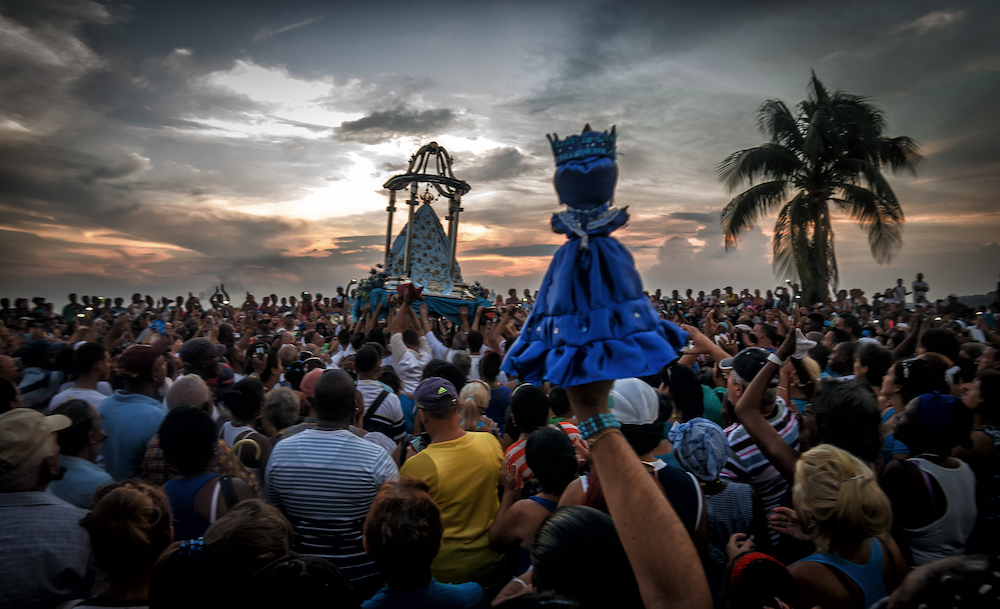
Regla is one of the 15 municipalities in the city of Havana. Accessible by ferry at the port in Old Havana. Regla, often missed by tourists, has a rich Afro-Cuban culture due to the freed enslaved Africans who settled in the area during the 19th century.
12. Visit Museo Municipal de Regla (Municipal Museum of Regla) – this important museum exhibits lots of history about Regla and Afro-Cuban religions.
Don’t miss the room dedicated to the Orishas (deities of the Santería religion), Palo Monte ngangas (cauldrons), and the masked Abakuá dancing figurines. The museum organizes guided tours of Regla for a small fee.
13. Explore La Iglesia de Nuestra Señora de Regla (The Church of Our Lady Regla) – originally a haven for enslaved Africans, this church is home to one of the most famous religious icons in all of Cuba, La Santísima Virgen de Regla (The Blessed Virgin of Regla).
In Santería, the Black Virgin Mary (Black Madonna) represents the African goddess of the ocean, Yemayá. Like most of the attractions in Regla, this church shows a combination of African and Catholic traditions.
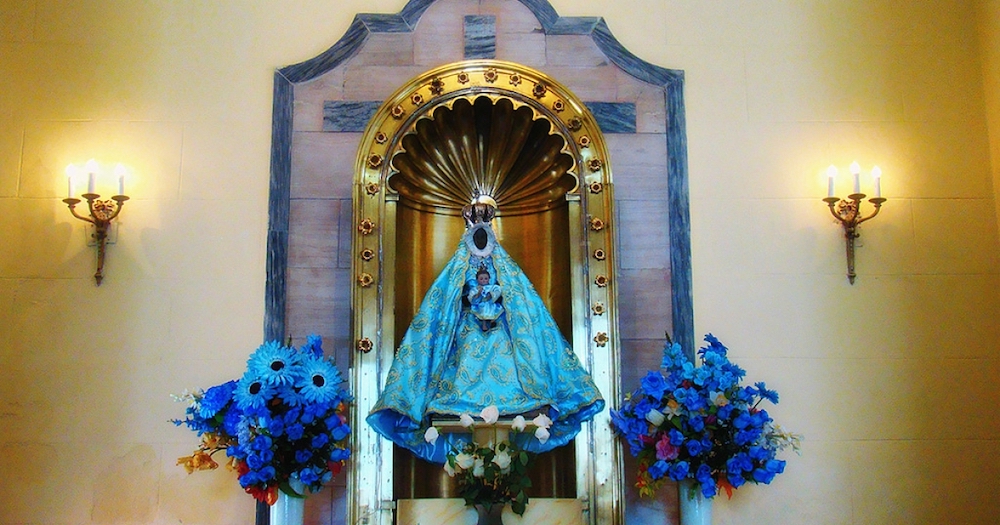
A festival to honor the virgin takes place every year on September 8th.
Guanabacoa
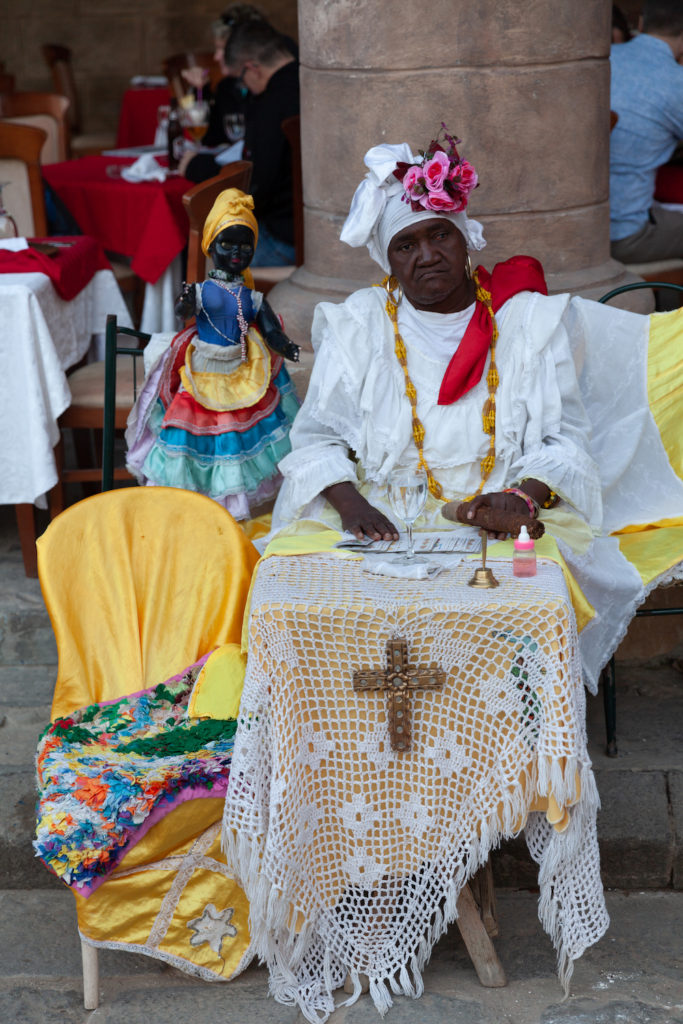
Guanabacoa is another municipality of Havana located next to Regla. Like Regla, Guanabacoa is accessible by catching a 10-min ferry from the port in Old Havana. This neighborhood is also known for its rich Afro-Cuban culture and religions: Santería (Regla de Ocha), Palo Monte, and Abakuá.
14. See the Museo Municipal de Guanabacoa (Municipal Museum of Guanabacoa) – similar to the museum in Regla, it is filled with important Santería artifacts introduced into Cuba by three African religious groups during slavery.
Don’t miss the rumba, folkloric shows, and rare artifacts from the Palo Monte and Abakuá religions. Pay particular focus on the Orisha Elegguá, the deity of the crossroads.
Trinidad de Cuba
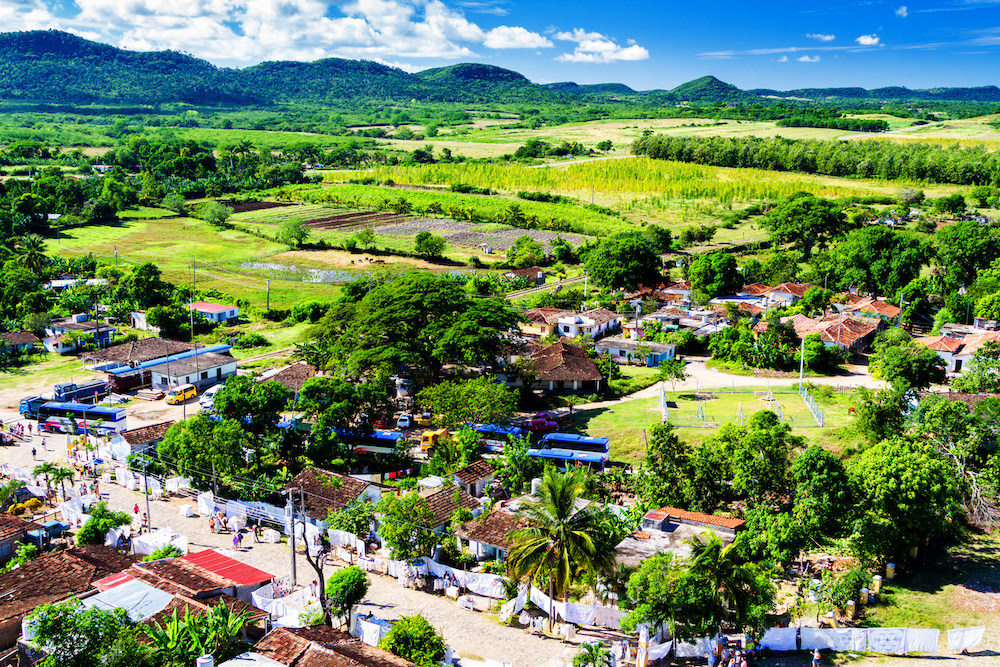
Trinidad is located in central Cuba. During the 18th and 19th centuries, Valle de Los Ingenios (Sugar Mill Valley) was the historical center of sugar cane production. Over 30,000 enslaved Africans worked in the mills and on sugar cane plantations.
15. Visit Manaca Iznaga – this 18th-century sugarcane plantation just 10 miles east of Trinidad became one of the biggest in the Valle de Los Ingenios and is infamous for trafficking enslaved Africans.
You can pay a small fee to climb the tower stairs to reach the observation deck, which has stunning views of Valle de Los Ingenios. The plantation owners used the tower as a lookout for overseeing the enslaved Africans.
A fun way to get to Manaca Iznaga is to catch the steam train from Trinidad. This railroad route dated back to the late 1800s and was created to transport sugar to the port town of Casilda.
16. Stop in at Casa Temple de Santeria Yemayá, The Yemayá Temple – This 18th-century house located near the Plaza Mayor Square is a Santería temple dedicated to the deity of the sea. Yemayá, the sea goddess, is dressed in white and decorated with fish representing her sons’ eyes. The religious temple and house symbolize the historical and cultural importance of the Afro-Cuban culture and local identity.
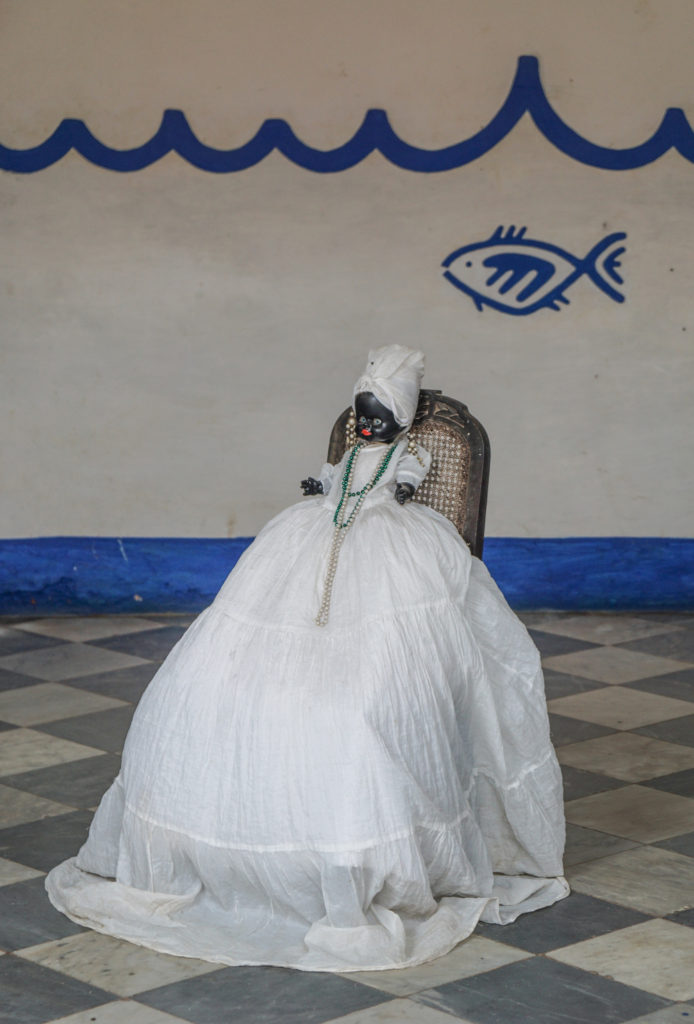
17. Enjoy live music at Palenque de los Congos – my casa particular host recommended visiting Palenque de Los Congos, and I’m glad we did! This traditional venue has some of Trinidad’s best Afro-Cuban drumming and live music. Folklore Afro-Cuban performances happen regularly.
We only planned to stop in for a few minutes but ended up enjoying this chill, not-so-tourist bar. The best of all is that regulars aren’t shy and will teach you how to salsa!
18. Dance the night away at Casa de la Música (House of Music) – I can’t think of a better night than dancing under the stars to live salsa and rumba music. Casa de la Música is conveniently located in Plaza Mayor.
At night, this outdoor venue comes alive with vibrant music and locals and tourists alike. After 11:00 pm, the locale turns into a nightclub.
Cienfuegos
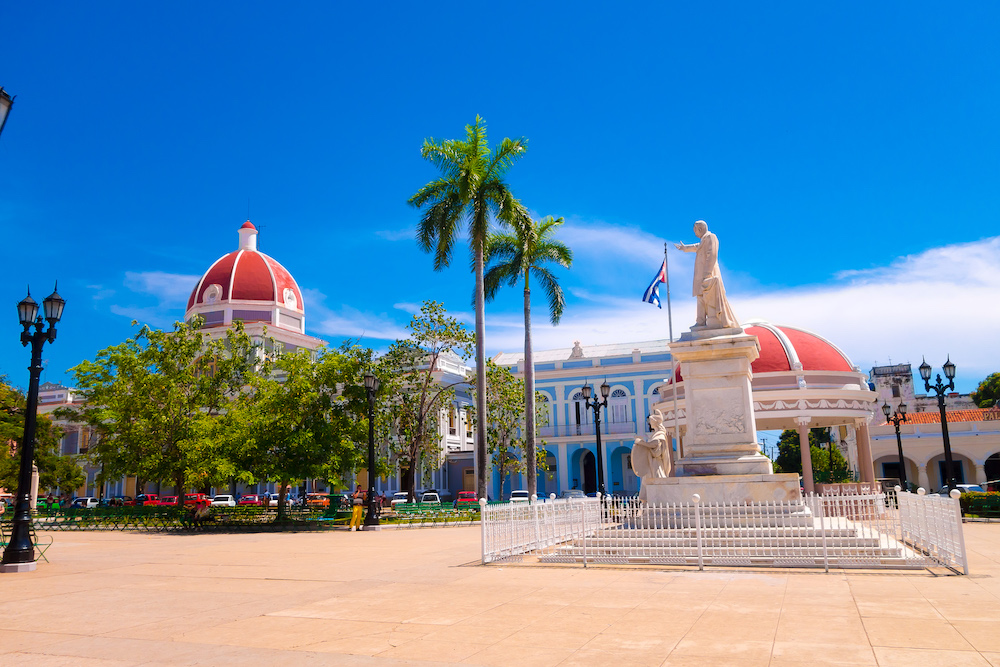
Cienfuegos, also known as La Perla del Sur (Pearl of the South), is located on the southeastern coast of Cuba. Founded by French colonists in 1819, this port became a commercial center for sugarcane, tobacco, and coffee. Enslaved Africans built the town, and today African cultural traditions remain.
19. Witness the Hemp Drum in Palmira – located 10 kilometers from Cienfuegos, the town of Palmira is known for keeping the Afro-Cuban religion alive by honoring and celebrating the Orishas through a celebration of drums of stick or hemp, song, and dance.
On December 4th, the main Yoruba festivity honors Saint Barbra and the Orisha Shango, god of war and owner of lighting and thunder.
Matanzas
![Afro-Cuba guide. The Slave Route Museum [Museo de la Ruta del Esclavo] at San Severino Castle in Matanzas, Cuba](https://travelwithladychin.com/wp-content/uploads/2021/09/Depositphotos_52146115_xl-2015.jpg)
Matanzas is located on the northern shore of Cuba and is one of the wealthiest areas of the island. Matanzas is known for its poets, music, dance traditions, culture, and Afro-Cuban folklore.
Enslaved Africans worked on sugar plantations during the colonial era. Due to the vast numbers of enslaved Africans and Afro-Cubans, African influence and traditions remain strong.
20. Visit the Museo Nacional Ruta del Esclavo (Slave Route National Museum) – this 17th-century San Severino Castle turned UNESCO-selected museum for the Slave Route Project.
The exhibits address the origins of plantation systems, abolition and emancipation, and the ongoing legacies affecting people of African heritage around the world.
Camagüey
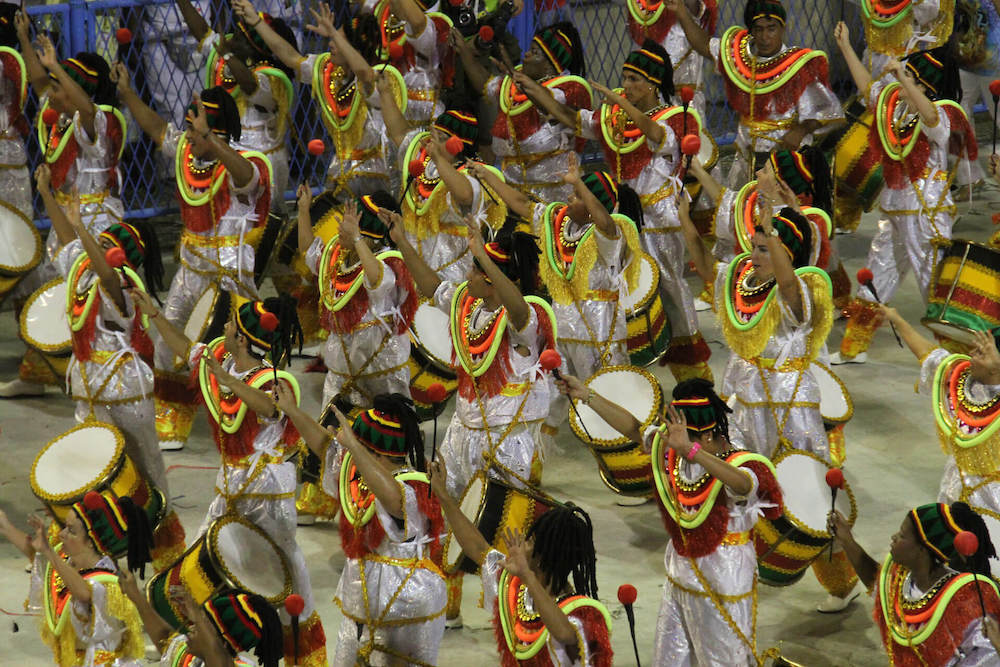
Camagüey, often overlooked by visitors, is the third-largest city in Cuba. In 2008, the historic center was named a UNESCO World Heritage Site. The labyrinth streets were intentionally designed to keep away and confuse pirates back in the day. It’s a charming area to wander and discover the unique street art, plaza, and history.
21. Enjoy the Camagüey Carnival – San Juan Camagüeyano, considered the oldest and most famous festival in Cuba. San Juan Camagüeyano takes place every June 24-29 and dedicates the celebration to the memory of the Saints Juan and Pedro.
Families come together to celebrate by the riverbanks, getting dressed up, making ajiaco, and dancing.
On the last day of the celebrations, a symbolic burial of San Pedro is represented by a Black doll followed by several weeping willows. The burning of the doll symbolizes purification and future economic prosperity.
El Cobre
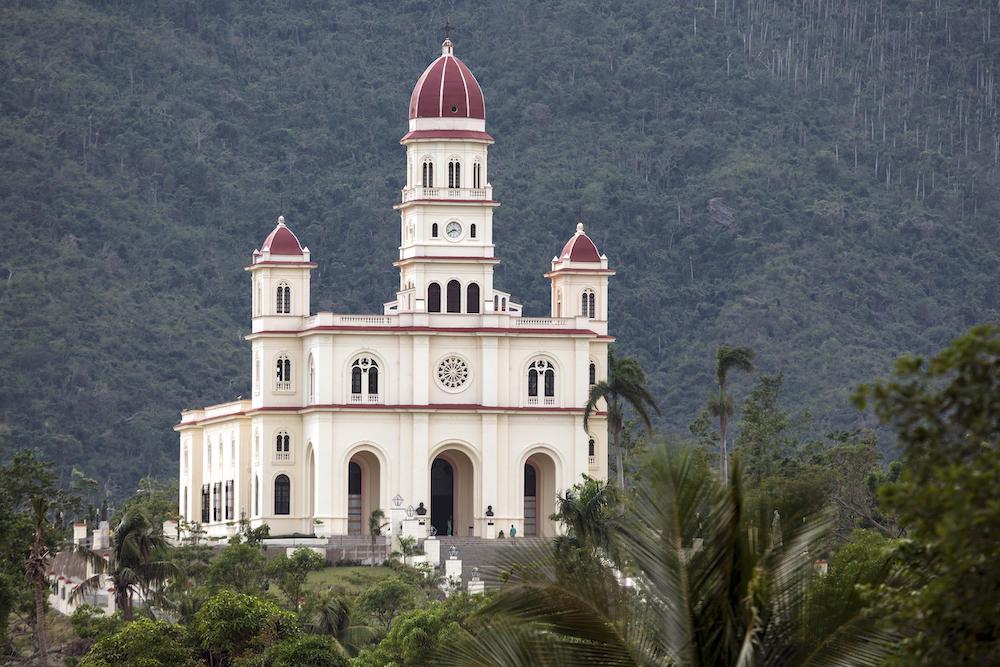
Located just 14 miles outside Santiago de Cuba, El Cobre is considered a milestone in the history of slavery in the Caribbean.
22. La Basílica Santuario Nacional de Nuestra Señora de La Caridad Del Cobre, (The National Shrine Basilica of Our Lady of Charity of Cobre) – this shrine celebrates the Catholic patroness Virgen de la Caridad (Virgin Saint Our Lady of Charity).
Many Cubans believe Virgen de la Caridad and African orisha Ochún to be the same due to her skin tone and bright yellow dress.
23. Go to the El Monumento al Cimarrón, (The Monument of Runaway Slaves) – directly across from the Virgen de la Caridad stands El Monumento al Cimarrón. The bronze and iron sculpture created by Afro-Cuban artist Alberto Lescay symbolizes resistance and freedom.
The monument glorifies one of the most significant slave uprisings in the island’s history – the successful July 24th, 1731, insurrection of enslaved Africans working in the mines of El Cobre.
Santiago de Cuba
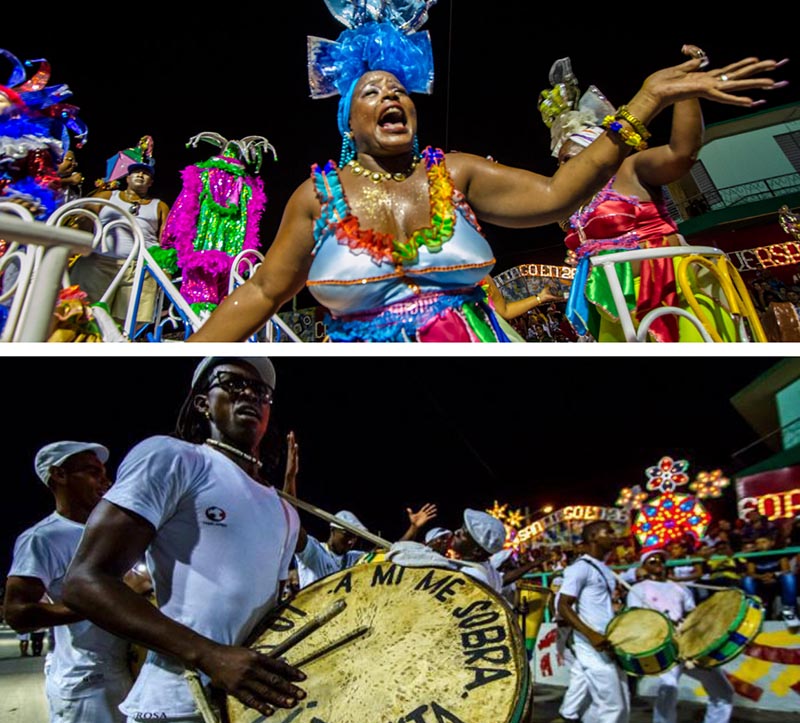
In eastern Cuba, Santiago de Cuba has the highest concentration of Afro-Cubans and is the second-largest city on the island. Due to the proximity, Haitian and Jamaican immigrants have settled in Cuba. This magical part of the island is known for its culture and traditional dances, most notably son, from which salsa has been derived.
24. Visit Museo del Carnaval (Carnival Museum) – Santiago de Cuba is considered one of the most vibrant festivals. This museum captures the essence of the city’s enthusiasm for the holiday.
Here you will go on a short tour to learn about the history of Cuba’s oldest and biggest carnivals between Río and Mardi Gras. The rooms display floats, extravagant costumes, carnival accessories, and effigies. Live performances are held throughout the day.
25. Have fun at the Carnival de Santiago (Santiago Carnival) – at one of the most famous and fun festivals in Cuba, the Carnival of Santiago de Cuba. Like many of Cuba’s festivals, Carnival de Santiago began as a religious event celebrated by Santigo’s enslaved Africans, who introduced dance, culture, music, and costumes typical of carnival.
Every year between July 18-27, Santiago de Cuba attracts visitors and Cubans alike to celebrate family and togetherness with lots of dancing, music, great food, and plenty of libations.
Tip: Temperatures in Cuba in July get extremely hot, so be sure to stay hydrated and wear protective sun gear.
26. Go to the Festival Del Caribe (Caribbean Festival) to immerse yourself in the culture and art and hear traditional congas.
The Caribbean festival runs during the first week in July (July 3-9) and is a fantastic opportunity to witness colorful performances, exhibitions, workshops, and street activities. The theme for the festival is unity among the entire Caribbean.
The Caribbean festival is similar to the Notting Hill Carnival in London. Mainly due to food from different parts of the Caribbean and all-night parties involving copious amounts of rum!
27. Spend an afternoon at the Casa del Caribe (Caribbean House) – a cultural institution that organizes the Festival del Caribe and hosts various concert nights. For a deep dive into the Afro-Cuban religions and cultures, the institution can arrange tours, workshops, and dance lessons for an additional fee.
The Casa del Caribe is split into two buildings a few blocks from one another. Casa II is located on Calle 8 and has a museum dedicated to Cuban deities.
28. Visit The House of Popular Religions, Santiago De Cuba – to explore the island’s religions, from Catholicism to Santería, and the unique rituals that meld the two. The entrance includes a guided tour of the Santériste temple and more.
29. See the Plaza de la Revolución (Revolution Plaza) – at the city entrance, an enormous monument of Afro-Cuban General Antonio Maceo Grajales at the city entrance.
The monument features Antonio Maceo atop his horse, surrounded by 23 giant raised iron machetes pointing towards the sky to signify the daggers on the sides of the colonial power.
General Maceo, nicknamed the “Bronze Titan,” was second-in-command of the Cuban independence wars. Beneath the monument is a modest museum dedicated to the General.
Afro-Cuban Tours
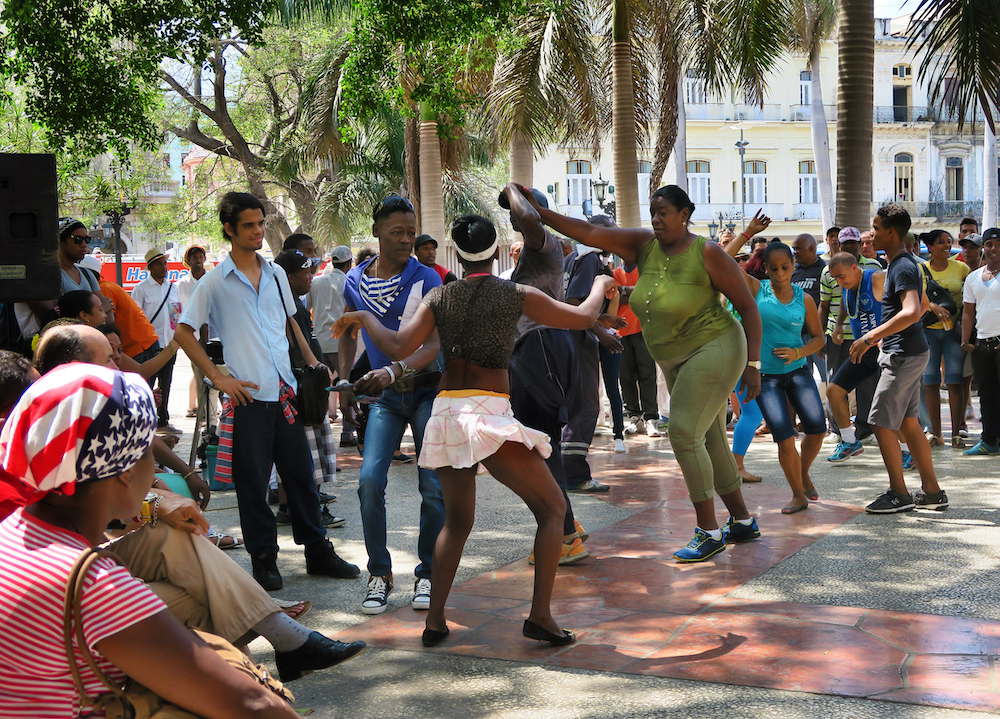
The tours listed below offer a firsthand opportunity to learn about Afro-Cuban culture, religion, and more. Admittedly, I haven’t had a chance to participate in any of the tours and would love to get your insight into which ones you prefer.
30. Urban Adventures – You’ll have the unique opportunity to learn about the Afro-Cuban religions, customs, folklore, and more from a local insider.
31. AfroLatino Travel – This company facilitates immersion activities of Afro-Cuban history, spirituality, legacy, and contemporary life.
32. Afro-Cuban Culture Guide – This Airbnb tour focuses on the legacy of African ancestry within Cuban culture and its influence on the daily life of the Cuban people.
33. Havana Adventures – Learn about the Afro-Cuban religion from an expert local guide who will show you around the neighborhoods of Central Havana.
34. Hosted Havana – This tour focuses on the spirituality of Afro-Cuban culture and religion in the small nearby town of Regla and Central Havana.
35. Stage 540 Cuban Cigar Tour – Co-founder Victor Ricardo Aguilera Sánchez offers a unique cigar-making experience. The workshops include lessons on proper rolling techniques, the history of cigars, and their importance in Afro-Cubans’ religious practices and life.
36. Afro-Cuban Tour – This five-day luxury tour specializes in the exploration of Afro-Cuban culture. Cuba Candela provides an exciting opportunity to witness and participate in spiritual ceremonies, cook Afro-Cuban meals, and where you’ll have the exciting opportunity to
Conclusion – Lady Chin’s Two Cents
After visiting the island several times and reflecting after every visit, I’ve concluded that Afro-Cuban culture is Cuban culture. Cuba is a fascinating island with a rich history and is more than just cigars, classic cars, and rum. The African influence, contribution, and preservation of the rich heritage are evident all over the island. My affinity towards Cuba will always remain strong. Superficially, I’ve been mistaken for a Cuban on numerous occasions, which has excited me to no end!
During your trip, I hope you explore some of the Afro-Cuban attractions that make this island so unique.
Have you visited any of the Afro-Cuban gems above? If so, what did you enjoy the most?
Related Posts
Before you go, if you liked this post, please share!
